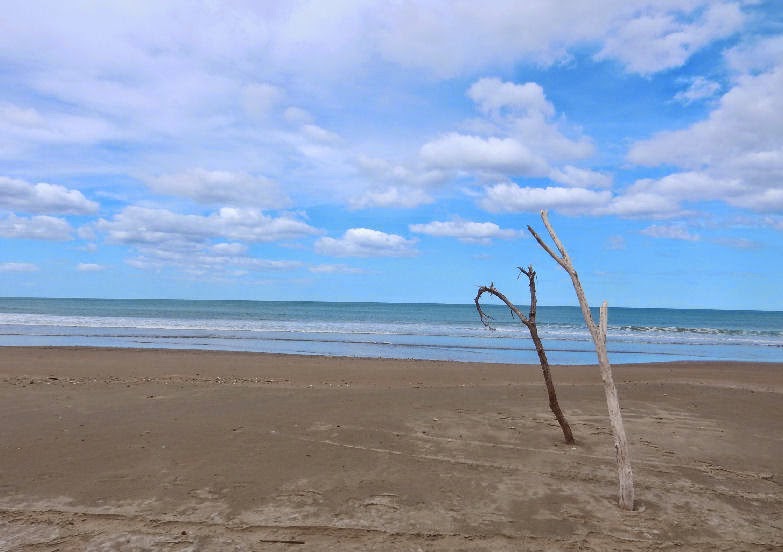The sky was grey and the wind was
blowing up a gale as Kaitaki, the Interislander ferry, glided out of Wellington
bound for Picton on the South Island.
Most passengers huddled up cosily in the café for the 3 hour journey but
there was no way I could stay inside.
For the majority of the crossing I could be found out in the fresh air
on the Observation Deck right at the top of the ship. You could say I looked a bit like the Michelin
Man of days gone by!
As we entered the Marlborough
Sounds the weather improved dramatically and by the time we docked at Picton
the sun was shining brightly. There was enough
time for a quick look around the pretty harbour and craft market before heading
off up into the mountains.
 |
| Picton Harbour |
The loos were
easy to spot with their bold yellow symbols on black wooden fencing. If you glance to the lower edge of the photo
you will notice that there are a couple of ladies already in the queue! Being a collector of dolls I would dearly
loved to have purchased one of these but, alas, my tightly packed suitcase
would not accommodate anything so delicate.
These loos were of the electronic
variety but came with the added feature of automatic flushing once the hand
basin was used i.e. wave your hands about in the sink to generate a flow of
water and that in turn triggered the loo to flush. If a patron did not wash
their hands then the loo would flush automatically once the door opened. Great
except automatic gadgets such as this never, ever seem to recognise me as a
human being. I waved my hands under the
water spout – nothing. I clapped my hands
under the water spout – nothing. For 3
or 4 minutes I stood there trying to get water to spray onto my hands –
nothing. I knew there was going to be a
queue outside – was I going to have to open the door to get the loo to flush
and let them all know that I was a person who did not wash my hands? Oh the disgrace of that! Suddenly, for no reason whatsoever the water
spouted into the hand basin, the loo flushed and I was saved from
disgrace. The only looks I got from
those in the queue were ones of “Why had I taken so long”!!
The 80 mile drive from Picton to
St. Arnaud was on Route 63 which runs alongside the Wairau River and through
the Marlborough vineyards. A long
straight road with views of mountain peaks in the distance.
 |
| Marlborough Vineyards |
Several settlements are marked on the map as
being on this road but for most of them not even one house could be seen from
the highway. Imagine my surprise when, in the middle of nowhere, I spotted the
familiar Public Convenience sign – STOP screeched the navigator (me). Fortunately, there had not been a sign of
another car on the road for the last half hour so this somewhat unexpected pit
stop caused no danger to anyone.
The sign pointed across the road
to a little church – The Wairau Valley Anglican Church. This came complete with large carpark to the
front and small rural cemetery to the rear.
The toilet was situated in a small room to the back of the building and
to the utter disbelief of my companion came equipped with large clean fluffy
towel with which to dry ones hands. Well done to the Wairau Valley residents
for keeping this loo in such an immaculate condition.
 |
| Wairau Valley Anglican Church |
Readers of this blog will know
how much I enjoy walking around old cemeteries so I spent a pleasant half hour
browsing the headstones before making use of “the facilities”. The only sound
which could be heard was the birds singing in the tree tops – we could have
been a hundred miles from the nearest civilisation. There was no need to hurry so I took my
time. Imagine my surprise when I
unlocked the door to find a queue of Japanese tourists waiting to get in!!!!
And so onward to St. Arnaud – an alpine
village situated on the edge of Lake Rotoiti.
The village boasts a café/shop/petrol station all rolled into one together
with several chalets and motels offering accommodation.
By this time the clouds had descended and it
was raining quite heavily. A short stop was
made for a hot cup of tea in the café before heading off in search of our
accommodation at St. Arnaud House.
The alpine chalet which is St.
Arnaud House is set in the midst of the forest with the Tui Room having views
out over the treetops to the mountain peaks. It is just a short walk down to Lake Rotoiti.
The hosts, Russell and Margery Chilton, ensure the comfort of their
guests by providing a roaring fire and interesting conversation. Anyone staying here would be well advised to
pay a little extra and take Margery up on her offer of dinner – an absolutely
delicious meal will be provided.
I awoke the next morning to the
sound of the Tui singing in the trees – and the sight of snow on the
peaks.
On learning that the theme of one
of my Blogs is “Toilets” Russell directed me to an unoccupied batch (holiday
home) opposite the end of their driveway.
Before we left I crept over to take a look.
Now this really is a
typical rural Long Drop
(and I assure you it
is NOT the toilet you will be expected to use when staying at St. Arnaud House!)
































